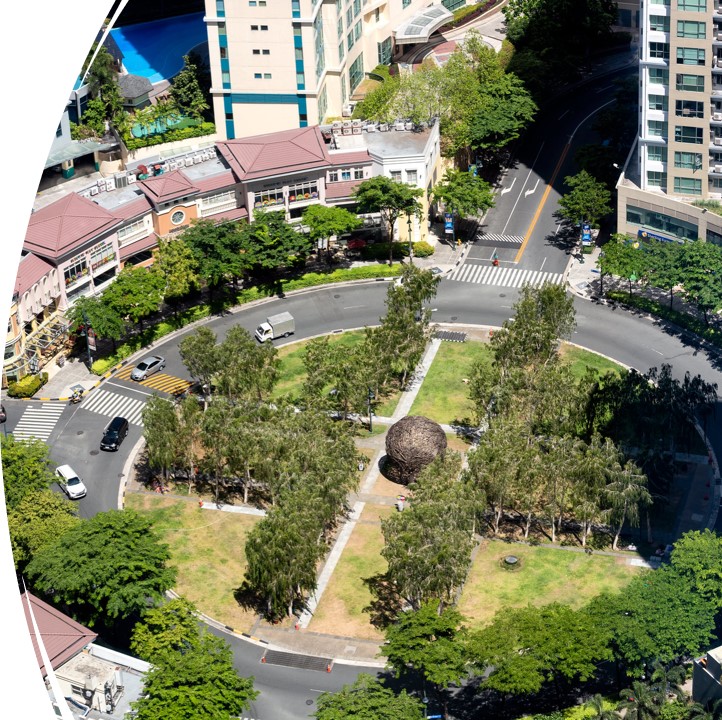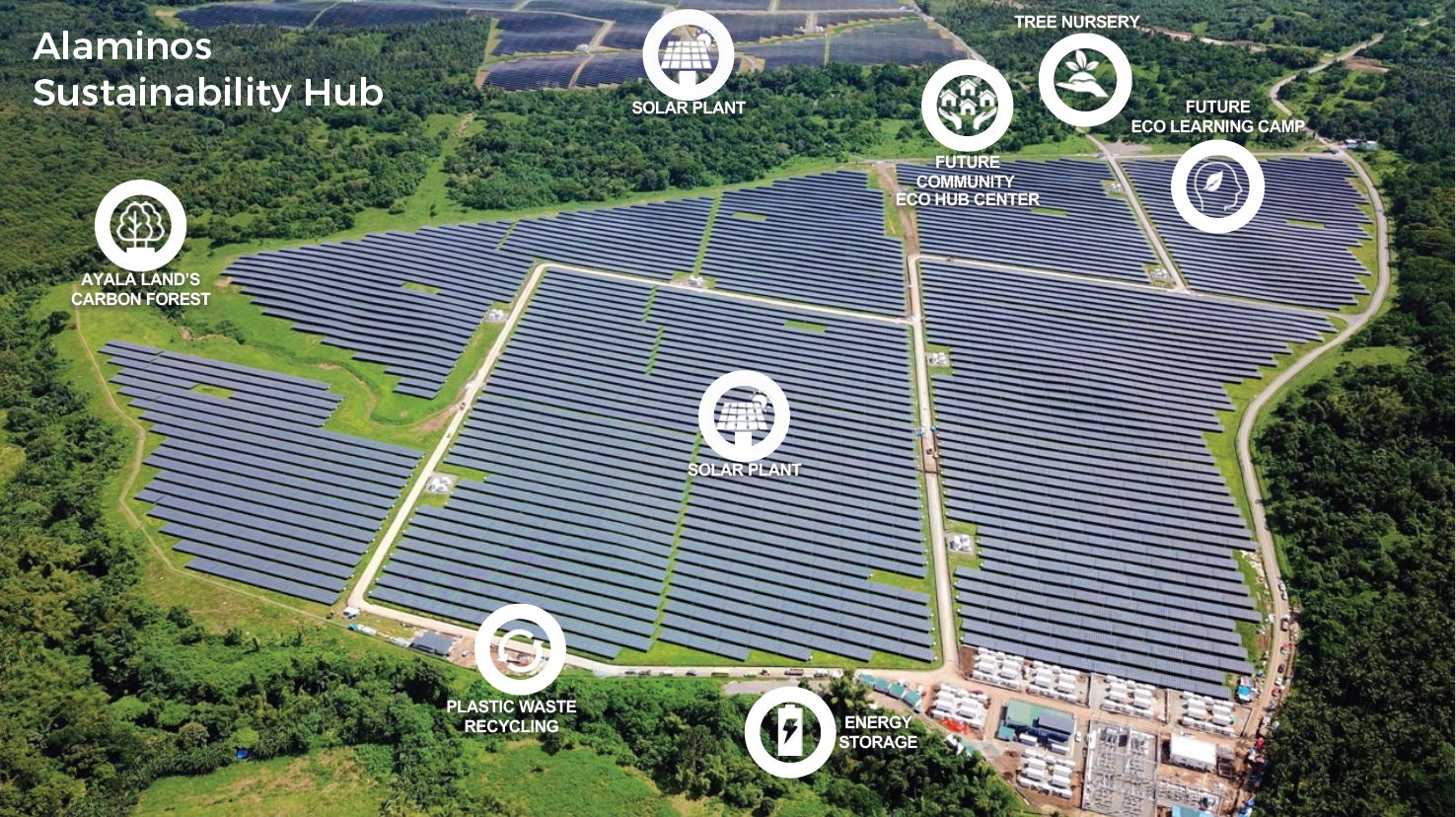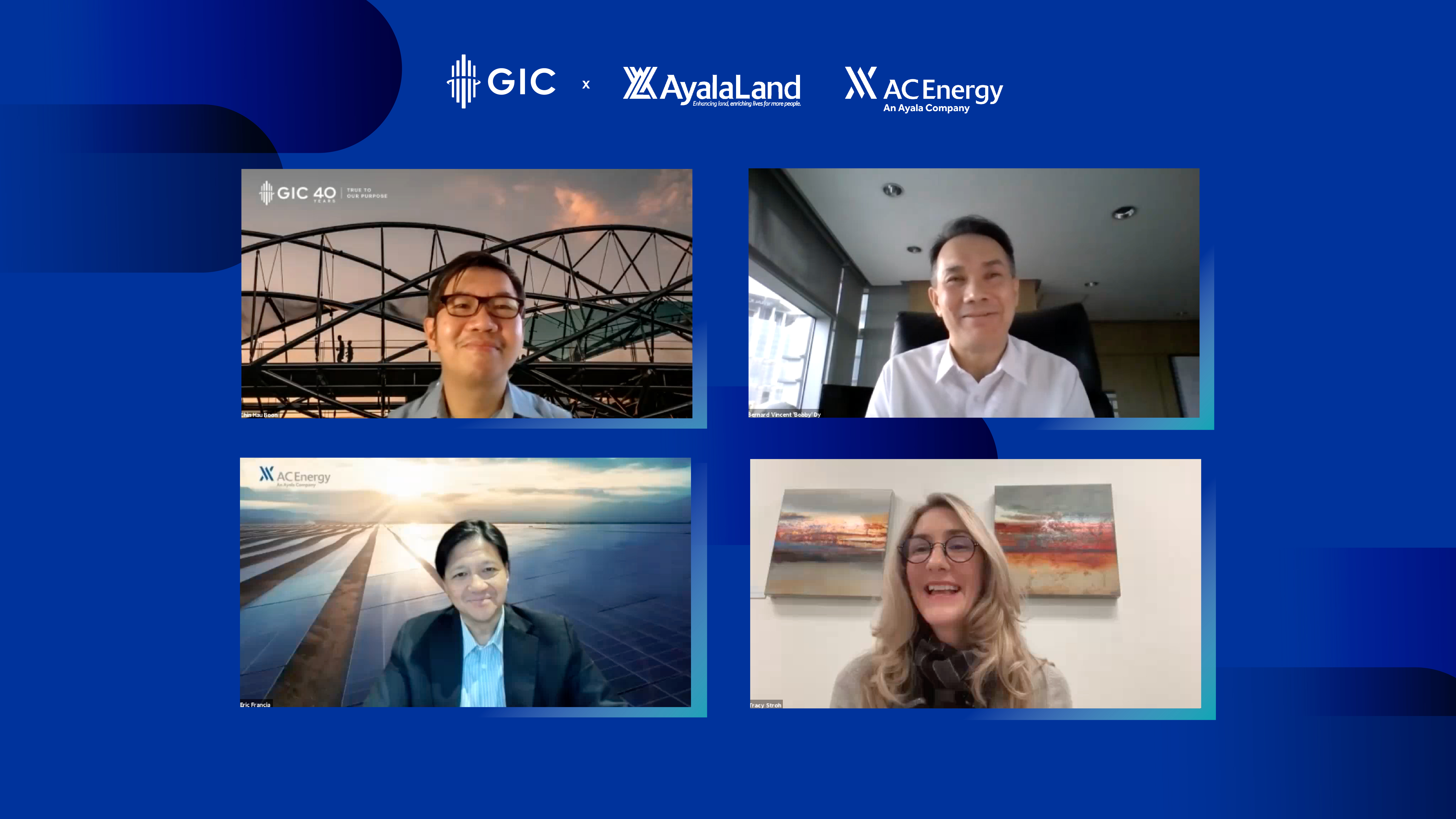This is an edited transcript of the GIC Speakers’ Series – Sustainability Edition with Eric Francia, President and CEO, AC Energy (ACEN), the Ayala Corp’s listed energy platform, and Bernard ‘Bobby’ Vincent O. Dy, President and CEO at Ayala Land, the largest property developer in the Philippines.
They were interviewed by GIC’s Tracy Stroh, Managing Director and Head of Real Estate (Europe), and Boon Chin Hau, Managing Director and Head of Infrastructure (Asia, Latin America and Credit), about AC Energy and Ayala Land’s approach to sustainability, and key milestones and challenges in their transition journey.
MANAGING EXPOSURE TO CLIMATE RISKS
TRACY: Real assets are becoming increasingly vulnerable to the physical impact of climate change, from extreme weather events to natural disasters. How are you managing exposure to these physical risks?
BOBBY: Extreme weather events, such as yearly tropical storms, and floods are something we are quite used to here in the Philippines. So as a real estate developer, climate-related physical risks are front and centre of our evaluations whenever we look at a new investment. When we do our due diligence, we typically assess for different geohazards such as liquefaction, fault lines and floods that used to occur every 50 to 100 years but are now happening more frequently. We have walked away from sites where we felt that the risks were not going to be manageable based on our projections.
Having said that, we are obviously a commercial business, so we ensure that for all of our estates, we seek to mitigate these physical risks, starting from the design stage.
For example, one of our resorts is located in El Nido, one of the seaside destinations in the Philippines, right by the water. So what we have done from a design standpoint is to place all developments 40 metres away from the high tide line, and elevate all our structures in anticipation of global warming and rising sea levels. We wanted to make sure that 50 or 75 years from now, the site will still be sustainable.
Another recent, significant impact of climate change is severe rainfalls in a short period of time which has the potential to cause significant flooding. So in many of our estates, we have integrated detention ponds and tanks to hold the water, to prevent our drainage systems from being overwhelmed, and to protect the surrounding communities.
As an example, underneath Burgos Circle in Bonifacio Global City is a detention tank, equivalent in size to eight Olympic-sized swimming pools, to store floodwater. During one of our worst floods in 2009-2010 caused by Typhoon Ondoy (Ketsana), Bonifacio was not affected because of these detention tanks which were able to hold the water and gradually release it into the drainage system.
In some of our other estates, we have rain gardens which function as detention ponds, and for most of our newer developments, we factor in and mitigate the physical risks associated with sudden and severe rainfall. As there are a lot of low-lying areas in the Philippines, we elevate our sites by one to two metres where necessary to reduce their exposure to flood risks.
Unfortunately, in the Philippines we are also accustomed to frequent natural disasters, but as an organization, we are really proud of our emergency response mechanisms. We have an emergency response team in each of our sites, a national crisis management team, and a 24/7 operations centre.
We monitor all our sites closely, and are able to mobilise resources whenever a natural disaster occurs in a particular area. Obviously, you can’t possibly anticipate some of these events, so we maintain adequate insurance for all our sites to make sure that our financial exposure is minimised.
ERIC: For our energy projects, we bake into our costings the higher capital expenditures (CapEx) required to mitigate climate-related physical risks.
Philippines CapEx are typically higher than those for Vietnam or India, and at least 10% of that delta is attributable to the fact that we are just a natural disaster-prone area, so we need to build according to stringent construction standards. That adds costs, whether it’s to account for stronger foundations, or Class 1 wind turbines which have shorter blades and lower capacity, which in turn increases the levelised cost of electricity.
As an example, for our solar farms, we bought quite cheap land because it was a lahar-covered area following the Mount Pinatubo volcanic eruption from decades ago. Flood protection and flood control infrastructure were critical as the area was known for heavy rainfalls, so we invested in technical studies. Fortunately, the structures we built and locations we selected based on the study are doing well. So you just need to invest in understanding the environment better.
Insurance and emergency response, as Bobby mentioned, are a given. Ayala Land is best in class, while we are still building up our capabilities in this space, but we benefit from being part of the Ayala Group. We leverage the strengths, synergies and best practices of the group, and don’t have to reinvent the wheel.
Lastly, with our renewables business, we diversify our locations. Diversification is good on many fronts. The more diversified we are, not only across the Philippines but also around the region, the better we are able to mitigate resource and physical risks related to natural disasters and climate change. That’s why you have seen our aggressive expansion across different parts of the Asia-Pacific.

Burgos Circle, Bonifacio Global City
COMMITTING TO 100% RENEWABLE ENERGY BY 2025
CHIN HAU: AC Energy has committed to transitioning to 100% renewable energy by 2025 – can you share more about your plans?
ERIC: This is on the back of our net zero commitment by 2050, and was approved by our board on 18 October 2021. This will see us work with an external consultant over the next 12 months or so to set a roadmap and some interim targets. A lot of it is a leap of faith, but we wanted something near-term and tangible.
Many of our investors have already been asking about the how, and I believe there’s quite a bit of nuance. From the Ayala Group’s perspective, we believe that in the energy transition, there is a role for fossil fuels, particularly natural gas, and we want to keep our options open.
That’s why we have selected Enexor, which is a publicly listed company that is majority owned by ACEN to transfer our diesel assets to, which are still important to address the intermittency of renewables for the next decade or so. But as many investors are concerned about putting more ACEN dollars into fossil fuels, we would like to ensure that Enexor is geared towards the energy transition.
We have to reduce our reliance on thermal energy over time through technologies such as green hydrogen, CCS or biomass. What would be the mission of Enexor is to develop these technologies, while ACEN can focus on scaling up renewables and battery storage.
Our divestment from coal by 2030 has also hit the news headlines because we were the first to make such a commitment in this part of the world.
On one hand, divestment from coal allows us to recycle our capital to scale up or invest in renewables. On the other hand, some might say that by selling off our coal assets, we might just pass the problem to somebody else. At least while the assets are under ACEN’s management, we can ensure responsible and transparent operations, and work towards mitigating our carbon emissions.
So we decided to retire our coal power plants in Australia and the Philippines by 2040 or earlier, which is 15 years ahead of their typical technical life of 40 to 50 years. We are making a bold statement that “25 years and that’s it”, and we will hold ourselves accountable to this pledge.
This is really about applying the just transition principle: We will not only transition from a technology perspective from coal to clean energy, but also transition the people and communities we interact with. Whether this involves reskilling, retooling or retraining people, we are committed to all of it. Given that we are also members of the Just Energy Transition Workstream with the Council for Inclusive Capitalism, this is us walking the talk.
I also wanted to highlight that the original concept of the so-called Energy Transition Mechanism (ETM) to facilitate the phasing out of fossil fuel power stations was pioneered by the Asian Development Bank (ADB), Prudential and few other global financial institutions. We loved the idea – we wanted to be first and move fast. We hope other investors will follow suit.
ACHIEVING CARBON NEUTRALITY BY 2022
TRACY: Ayala Land announced earlier this year that it was 91% carbon neutral, on track to reach carbon neutrality in 2022. As the largest property developer in the Philippines, how did you achieve this? What were the biggest challenges and how did you overcome them?
BOBBY: We are on track to achieve carbon neutrality this year across all our commercial assets, including malls, offices, hotels, motels and resorts. We obviously also sell residential products but we have limited control over those developments.
Our carbon neutrality journey started in 2016, when the industry put an increasing focus on becoming more energy efficient, introducing new building standards, and getting buildings certified. We were working towards greater energy efficiency, and based on the numbers, we were making progress in terms of reducing our carbon footprint on a per asset basis. But because our business was growing at a fairly significant pace, our overall carbon footprint also increased. So, we wanted to find out how we could mitigate our carbon impact as we continue our growth trajectory.
On a personal note, one day, my daughter asked me: “What are you doing to protect the environment?”, which spurred me to identify what goals could help us improve our environmental impact, and which we can be proud of as an organization.
We have a culture of setting really ambitious targets, but frankly, when we set those goals, we did so with our eyes closed and fingers crossed. I felt that once we set a goal, it will mobilise the whole organization to look for solutions to reduce our carbon footprint.
We are not scared of failing, because setting those ambitious goals will only mean that even if we fail, we will end up in a better place compared to before.
- The first lesson is to set ambitious goals and make them public, so everybody knows we are serious, and so we are held accountable to meet those targets.
- The second is related to developing yearly emissions targets.
- The third is all about strategy, including what amount of land can be reforested as a carbon sink, and buying as much economically viable renewable energy as possible. There is obviously a cost associated with these efforts, and we have to integrate that into our business model.
- And finally, funding. Once we identified the costs, we had to find ways to fund it, so we introduced an internal carbon tax which is part of the P&L of all our assets.
As of today, 48% of our energy is sourced from renewables, 39% is offset through our carbon forest, and the remaining 13% is offset through carbon offset certificates.
The main challenges are costs and availability, especially when businesses are suffering because of COVID-19, but we remain committed to this pledge regardless.
OTHER ESG AREAS THE COMPANIES ARE FOCUSING ON
CHIN HAU: AC Energy by definition is an ESG-friendly company given your work in renewables. Are there other ESG areas that the company is focused on?
ERIC: We have just published an environmental and social (E&S) policy and management system that incorporates not only our renewable energy projects, but also programmes focused on biodiversity, including forest protection, reforestation and agroforestry, providing a source of livelihood to the communities we are operating in.
Working together with clients and partners is also key. As an example, we have partnered with Ayala Land to develop the Alaminos Sustainability Hub which is built on a land owned by Ayala Land spanning more than 300 hectares. 100 hectares of that land is taken up by a 120 MW solar plant and a 40 MW-hour energy storage unit which is about to fire up anytime now.
Ayala Land essentially enabled this project by signing a long-term offtake agreement in April, so it’s not just about buying renewable energy from a plant that already exists, but enabling the investment into that power plant.
Surrounding the hub is the carbon forest mentioned by Bobby which helps offset part of Ayala Land’s carbon emissions. We have also incorporated a number of circular economy practices in our plans, including the recycling of all our plastic waste. Ayala Land introduced us to upcycling plastic trash into so-called eco-bricks which we use for the building structures, and we hope to continue this practice.
Finally, we are building an eco-learning camp and an eco-friendly conference centre to host and educate our various stakeholders, including students and companies, on the different aspects of sustainability.
This project is an exciting endeavour which we also hope to replicate with other partners.

Alaminos Sustainability Hub
HOW CAN LONG-TERM INVESTORS HELP?
TRACY: What can long-term investors like GIC do to support companies such as AC Energy and Ayala Land in your transition journey?
BOBBY: Our board has approved yesterday our plan to achieve zero greenhouse gas emissions (GHG) by 2030, including Scope 1 and 2, and to reach net zero by 2050 which will cover Scope 3. This will apply across all our commercial and residential assets. We aim to become 100% renewable energy-powered where regulation allows, and emissions that will have to be offset would be done through our carbon forest and other carbon removal projects.
And to achieve these goals, support from long-term investors such as GIC would be great in the following areas:
- Accelerate the development of green technologies – steel production is one example where the use of coal is still the best option and alternatives such as green hydrogen are not yet commercially viable;
- Encourage our industry peers who don’t currently have the same green commitments to also decarbonise;
- Advocate for a whole-of-society approach, including more regulatory and government support.
ERIC: All I would like to add is that we would love to leverage GIC’s vast network for market development, new technologies or sustainability best practices, especially with regards to the many unknowns in this journey towards net zero.
Click on “Save as PDF” for the PDF version of this transcript.







